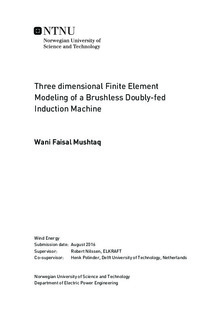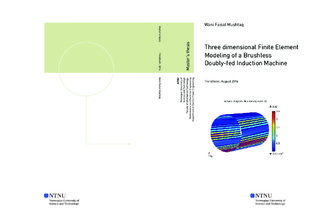| dc.description.abstract | As we move deeper into offshore waters to harness more of wind energy there is a need to
keep the total operational and maintenance costs to a minimum, of which expenditures related to the generators form a major share. Brushless Doubly-fed Induction machine used as a generator, due to the requirement of a lower rating converter, and the absence of brush-gear and slip-ring arrangement can help in mitigating those costs.
2D models of the BDFIM have been developed to arrive at a better design so that the machine is able to compete with and possibly, outperform other solutions in the market. However, much like 2D models of the other machines, these models usually neglect or at best approximate certain practical aspects. These aspects mostly include effects arising due to physical features such as end windings, laminated structure of the iron, skew in the conductors, etc. 3D modeling can allow us to more accurately model these effects and perhaps, result in an even more efficient design. However, there are some caveats in this approach. 3D models, as expected, are mathematically more complex to formulate and solve. Besides, there is a multifold increase in the number of unknowns to be solved for which poses a significant challenge in terms of the memory requirement and the time cost of the model. The methods adopted to solve 2D problems hitherto, magnetostatic as well as transient, are not suitable to solve large scale 3D models.
The objective of this thesis is primarily to present a strategy to efficiently solve such 3D problems. In this regard, different magnetic potential formulations were considered, and the mathematical properties of the matrix system resulting from each formulation were outlined. Special emphasis is placed on the implementation of iterative solvers and multigrid preconditioning. Also, it will be demonstrated that a formulation resulting in fewer degrees of freedom does not necessarily translate into a memory and/or time efficient model.
This approach is then extended to estimate the axial flux in the BDFIM arising from the
skewed rotor. In the 3D model, we consider the axial flux component and anisotropy of the iron which are neglected by the 2D multi-slice model. Upon analysis, it was observed that incorporating these effects leads to minimal improvement over the 2D multi-slice model which, however, more than outweighs this improvement by being computationally less expensive. | |

